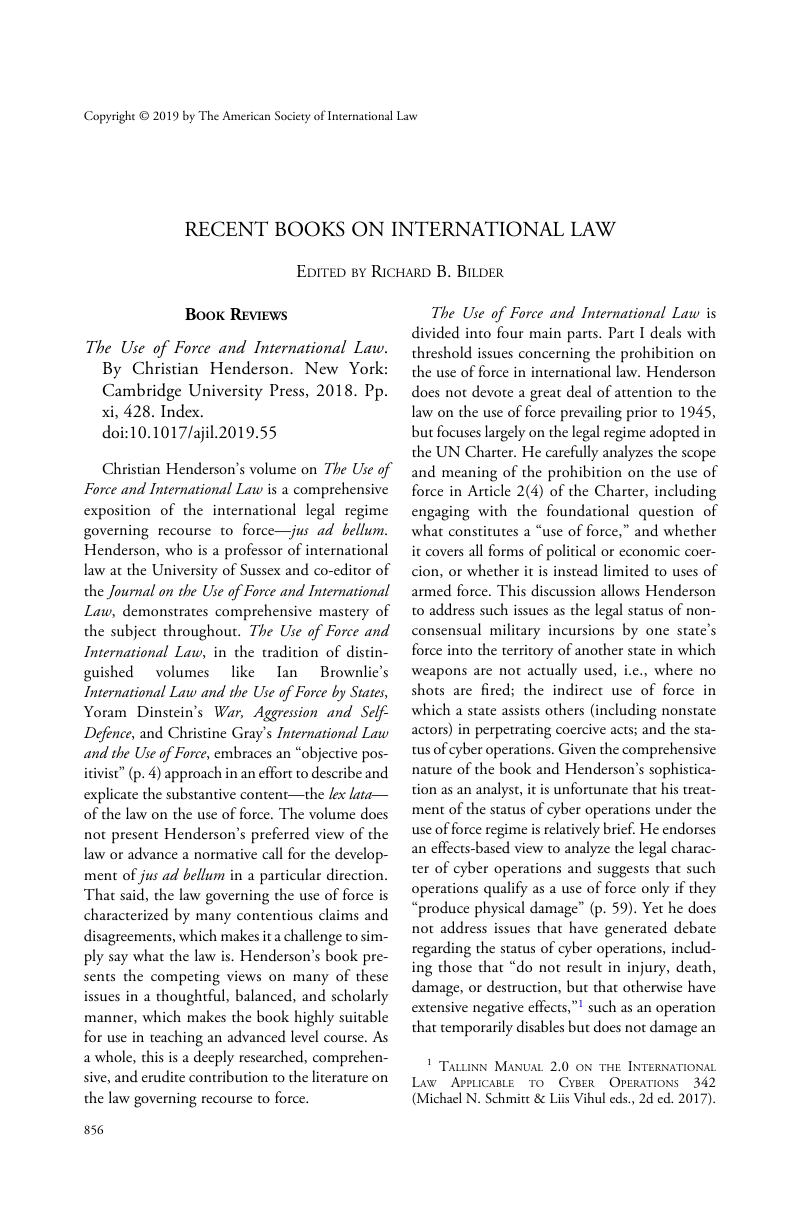No CrossRef data available.
Article contents
The Use of Force and International Law. By Christian Henderson. New York: Cambridge University Press, 2018. Pp. xi, 428. Index.
Review products
Published online by Cambridge University Press: 18 October 2019
Abstract

- Type
- Book Reviews
- Information
- Copyright
- Copyright © 2019 by The American Society of International Law
References
1 Tallinn Manual 2.0 on the International Law Applicable to Cyber Operations 342 (Michael N. Schmitt & Liis Vihul eds., 2d ed. 2017).
2 Henderson cites, as an adherent of this view, Quigley, John, The “Privatization” of Security Council Enforcement Action: A Threat to Multilateralism, 17 Mich. J. Int'l L. 249 (1996)Google Scholar.
3 See, e.g., Barry E. Carter, Allen S. Weiner & Duncan B. Hollis, Aspen Casebook Series: International Law 1020–35 (7th ed. 2018); Thomas M. Franck, Recourse to Force: State Action Against Threats and Armed Attacks 39–44 (2002).
4 Case Concerning Military and Paramilitary Activities in and Against Nicaragua (Nicar. v. U.S.), 1986 ICJ Rep. 14, 101, 110 (June 27).
5 Bellinger, John B., , III, Speech – Legal Issues in the War on Terrorism, 8 German L.J. 735, 737 (2007)Google Scholar.
6 Brian Egan, Legal Adviser, U.S. Department of State, Address before the 110th Annual Meeting of the American Society of International Law, International Law, Legal Diplomacy, and the Counter-ISIL Campaign: Some Observations, reprinted in 92 Int'l L. Stud. 235, 241 (Apr. 1, 2016).
7 Case Concerning Oil Platforms (Iran v. U.S.), 2003 ICJ Rep. 161 (Nov. 6).
8 It is possible that Henderson bases this view on his belief that “non-international armed conflict encompasses ‘only the most intense and large-scale conflicts’” (p. 364), and that it is unlikely that sequential attacks against non-state fighters could thus be part of a single armed conflict. That belief seems to be belied by the fact that Henderson's call for a “separate self-defence assessment to be undertaken on each occasion” is included in a section of the book discussing killings under international humanitarian law, which presumes the existence of a state of armed conflict. Moreover, Henderson's claim that only the “most intense and large-scale conflicts” can qualify as non-international armed conflicts strikes me as wrong.
9 See, e.g., Weiner, Allen S., Just War Theory & the Conduct of Asymmetric Warfare, 146 Daedalus 59 (2017)Google Scholar; Weiner, Allen S., , Hamdan, Terror, War, 11 Lewis & Clark L. Rev. 997 (2007)Google Scholar; Weiner, Allen S., Law, Just War, and the International Fight Against Terrorism: Is It War?, in Intervention, Terrorism, and Torture: Contemporary Challenges to Just War Theory in the 21st Century 137 (Steven P. Lee ed., 2007)Google Scholar.
10 Weiner, Allen S., The Use of Force and Contemporary Security Threats: Old Medicine for New Ills?, 59 Stanford L. Rev. 415, 434–47, 440–41 (2006)Google Scholar (reviewing “international assessments” of claimed rights of self-defense against terrorism and WMD threats).
11 Franck, Recourse to Force, supra note 3.
12 Reisman, W. Michael, Assessing Claims to Revise the Laws of War, 97 AJIL 82 (2003)Google Scholar.
13 Franck, Recourse to Force, supra note 3, at 7.


